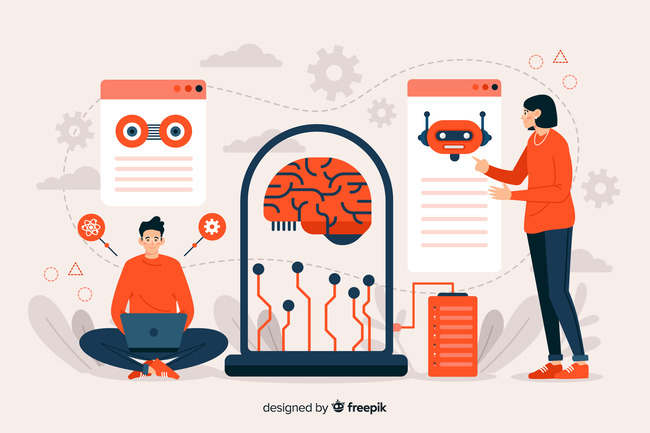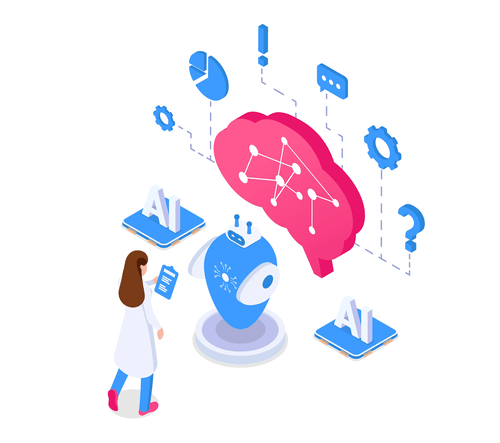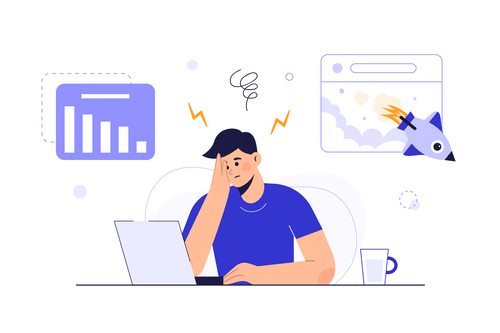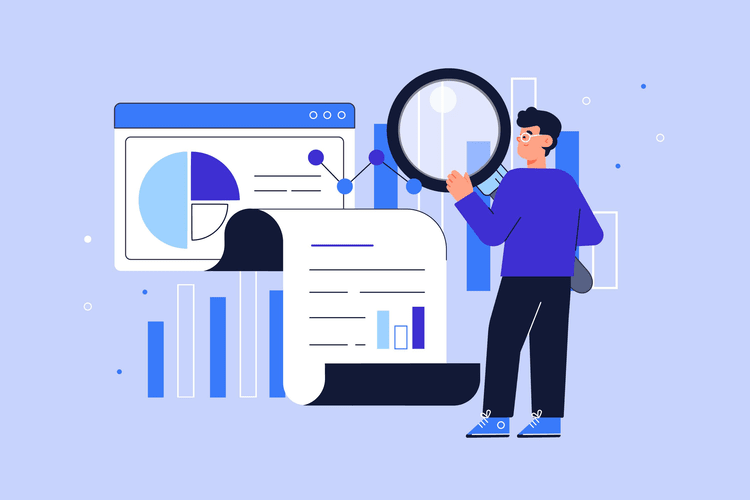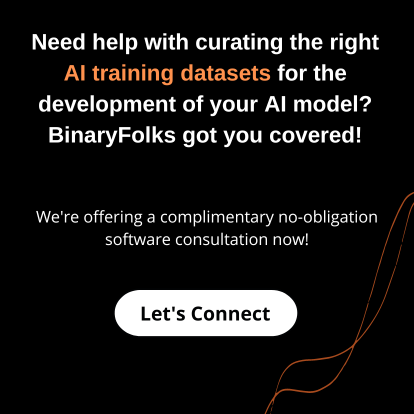Would you allow an AI-powered medical robot to operate on you if it only had a measly 40% success rate? What about 50%? Doesn’t sound like a very promising idea, right? We as humans always tend to opt for the most reliable option, the closer to 100%, the better, but what is the most significant factor that helps an AI model bridge the reliability gap? AI Training Data!
With you landing on this blog, chances are that you are fascinated by the idea of developing an AI model and are just starting off with the actual execution. A road that will inevitably lead you to seek AI development services from a software development firm. Why? Because AI development is complicated. The very first step of building an AI model is finding the right data set for training, and if you think with so many datasets available online, finding the perfect dataset for you will be as easy as finding the highest rated cafe near you, let me introduce you to reality. The chances of that happening is very slim, you might get a good data set if you are lucky, but getting a “Perfect” one needs a plethora of extra checks. There’s a lot of fundamentals that go behind selecting the right datasets and then building a solution on top of it, most of which we will be discussing in this blog.
But that’s not the only thing we will be focusing on. Suppose you managed to find a proper dataset, even in that scenario, there are way too many nuances one might need to look into. An inexperienced team does not have a broad perspective to build an AI solution that can execute a use case properly across all of the possible scenarios. But before we get into that let’s start from the inception.
Discuss Your AI Business Doubts with Experts
What Is AI Training Data?
Simply put, AI training data is the information used to teach AI systems how to perform specific tasks or make decisions.On a more technical note, AI training data is labeled or structured information that consists of input and output values which is used by the AI model to define an algorithm for itself. The AI system learns patterns and relationships from this data, enabling it to generalize and make accurate predictions or classifications when faced with new, unseen data. This algorithm is further used by the model to predict the output and inputs for similar queries where either of the data is missing.
Why Do We Need AI Training Data?
Just like humans learn from experience, AI systems learn from examples provided in the training data. This data provides the AI model with the necessary experience in a particular field which helps them make predictions more accurately. The more well-defined and diverse training data is fed to the model the better the accuracy of the model becomes.
Imagine you're teaching an AI to recognize cats. The training data would consist of various images of cats, each labeled as "cat." The AI learns from these examples, identifying common features like ears, whiskers, and fur patterns associated with cats. As it encounters new images, the AI applies what it learned from the training data to recognize whether there's a cat in the picture.
How Important Is Data For Training AI?
We have already established the importance of data for training AI, it is without a doubt one of the most crucial aspects of developing an AI solution from scratch. However, the quality of the data is something that needs to be assessed at all points, especially in case the model is being trained under an unsupervised setup. If the quality of the dataset is poor, the AI model may take a big hit on its reliability and sometimes become outright unusable.
How Can Bad Data Affect The Performance Of An AI Model?
Before understanding the effect of bad data on the performance of an AI model, we need to understand what counts as bad data for an AI model. Does it only consist of unorganized and random datasets? NO. Even if the data is well-labeled and structured, it is not definite that the AI model built on top of it will be flawless. Many AI development teams make the mistake of training the model on a biased data set.
Think of it this way, if a political enthusiast is following a news channel that is carrying out the agenda of a single party, the viewer will inevitably develop a biased opinion. The same is relevant for an AI solution, if you are training it with datasets that are biased to begin with, the model that will come out will reflect the same characteristics.
Alternatively, if the political enthusiast is following multiple channels that talk about the pros and cons of different parties, or if they follow a channel that gives an overall idea of each party, the opinion formed by it will be much more reliable than the prior case. Similarly, if the AI is trained with a dataset that covers a diverse variety of inputs and outputs, the resulting model will be significantly more reliable compared to the prior situation.
Additionally, the presence of noise in the training data, such as irrelevant or misleading information, can confuse the learning process. The AI model might pick up on these irrelevant patterns, resulting in decreased accuracy and reliability. Got the right data that passes these self assessments?
Start Building the Solution with BinaryFolks!
What Are The Alternate Ways If We Do Not Have Or Cannot Gather Training Data?
Data is abundant, in most cases you will be focused on gathering and structuring the data rather than looking for it. However, in the slight chance that your use case does not have any data readily available, or if you are struggling to find sufficient and evenly distributed data as we discussed previously, there are a few alternative methods to turn to that will support your model to train itself up to a respectable position. The first method we want to discuss is –

[1] Generating Synthetic Data
This method relies on the hope that before the development of an AI model the client and the software development team have some rudimentary understanding of how the AI model would behave once it is completed. Based on this vision, the devs and the organization can simulate a virtual environment that generates synthetic data which can be used to train the AI model. Synthetic data mimics the characteristics of the real-world data you're targeting. Although frankly speaking, it might not be the most cost-effective option. This is where the next option comes in handy.

[2] Transfer Learning
Imagine you want to develop an AI model that can imitate the behavior of a tiger, but no AI training data set has the relevant data to train this model. However, multiple datasets contain the data to train a model to behave like a cat. Do you see where I am going with this? We can take the Cat’s data set and make tweaks to the model at the points where these two species act differently based on our understanding or the help of a wildlife expert, and leave the common fields the way they are. This way even though we did not have the exact data available from the get-go, we were able to take a closely related data set to train the unique model we wanted, that’s what transfer learning does for you!

[3] Data Augmentation
If you have a small amount of data, you can artificially increase its size by applying various transformations like rotations, flips, or color adjustments. By creating modified versions of your existing data points, you can significantly increase the diversity and size of your training set. Data augmentation can potentially improve the model's generalization capabilities.
How Do We Get AI Training Data?
Sorry to scare you in the beginning with the data-gathering process before getting to this point, but there’s a high chance that the data-collection methods we mentioned will not be relevant to you whatsoever. To find the right training data means to know what you are looking for, and as long as it isn’t like the hidden treasures of Atlantis, it is very likely that you will have the training data for your needs! Heck, you might even have it on you already, you just don’t realize it yet! Let’s discuss some of the most well-known mediums to get your AI training data.
First up, Open source datasets, one of the most common ways of obtaining training data as the data available online is versatile, elaborate, and well organized, a perfect combination for developing an AI model.
Second, Internal Data, your business data, or first-hand data as the people in the industry like to call it, is undoubtedly the most relevant to your business model because that’s where it originates from, but before using it make sure it is labeled, and organized instead of just being randomly scattered.
The third approach would be crowdsourcing the data, you know surveys and stuff, where you ask a bunch of volunteers from various demographics to fill up answers for predefined questions which will be eventually fed to the AI model.
What Are The Most Reliable Sources To Obtain AI Training Data?
When it comes to data sources to collect AI training data, you get a wide range of options for any approach you wanna take. For example, if your AI needs to work on General Datasets, sites like Kaggle, OpenML, and GitHub can be great sources to find datasets for AI training. But that’s nowhere close to being it. We’ve also got domain-specific repositories like Amazon and Microsoft Azure’s open datasets, Google even has its dedicated search engine called “Google’s Datasets Search Engine” for finding relevant datasets which can be used to train AI models.
We’ve even got universities contributing to these data sources with UCI Machine Learning Repository and Harvard Dataverse being some of the most well known names in the lot.
Even the government entities of multiple nations contribute to this global data repository including the Data.gov website from the US, European data from the European government, and data.govt.nz, data.gov.in from New Zealand and India respectively.
Conclusion
But this is still barely the tip of the data iceberg available on the internet. Like the 75-80% of the AI models being built using these datasets, you can rest assured that your use case will most likely have multiple datasets out there!
With so many datasets available you can easily find training data for your AI model, but whether it is the perfect dataset or not is still gonna be a giant question mark. Only an expert, with hands-on experience with building AI models can differentiate between a somewhat relevant dataset and the dataset that will take your model to the next level. And here at BinaryFolks, our development team is not just experienced with building AI models, they are passionate about it!
We will help you explore various data sources, by considering public datasets, industry repositories, and potential proprietary databases. Collaborating closely with you, we will either recommend or help you devise a data collection strategy and offer expertise in processing techniques to ensure data quality. Then we build AI models based on the identified dataset, by leveraging advanced algorithms and a spectrum of techniques like machine learning, natural language processing (NLP), computer vision, speech recognition, and many others to extract meaningful patterns and insights. Our iterative model training approach, coupled with continuous collaboration, ensures the development of accurate and robust AI solutions for your specific requirements.
The testament of our work is reflected in our record of 94% returning clients from over 17 countries who recognized our passion and the quality of work we put out. Anytime they have the need for a new project, they always know where to ring up!
Be it a big shot enterprise business or a small group of visionaries just starting up their company, we have served them all. From helping you find the perfect dataset to training your AI model to do exactly what you are manifesting right now, we have got you covered for your entire AI development venture!
Discuss Your Unique Business Questions with Professionals



